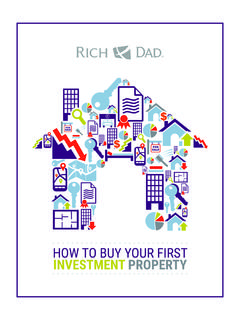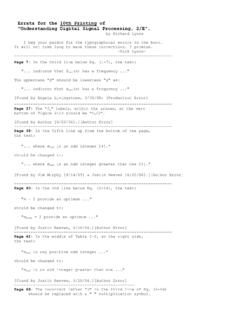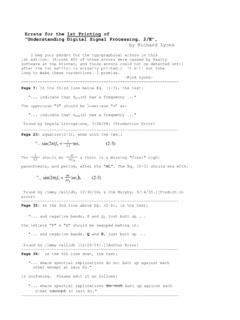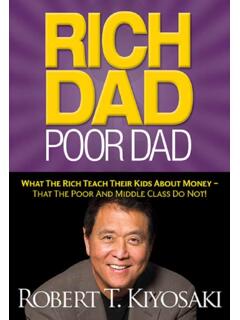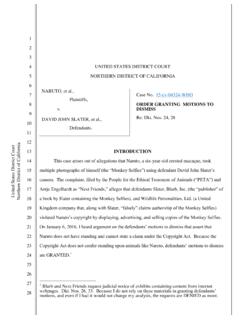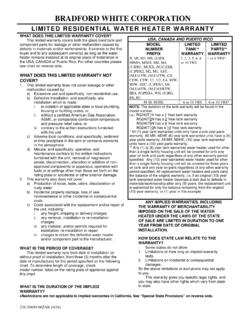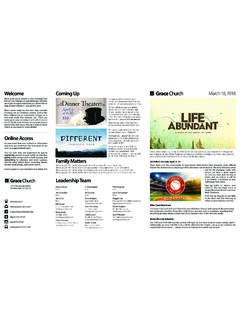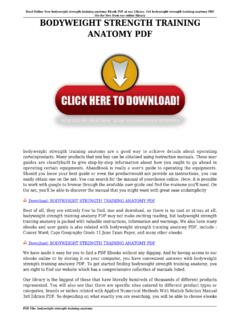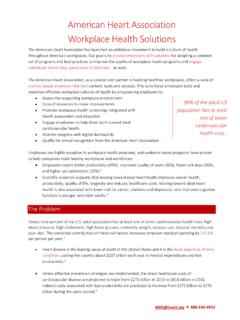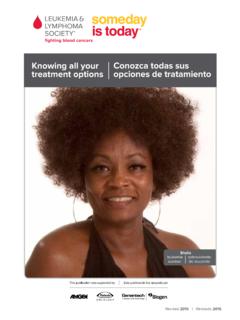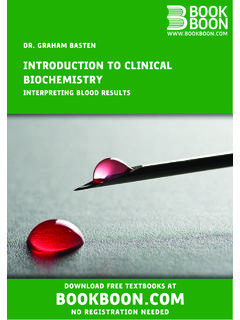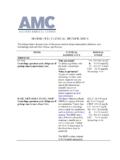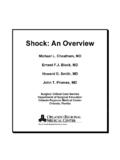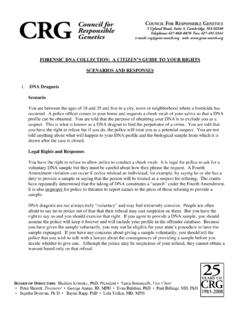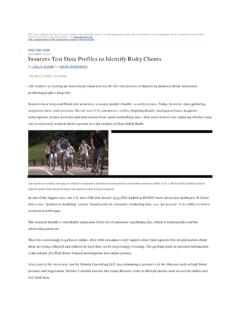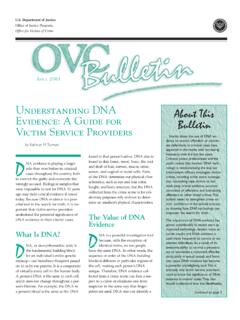Transcription of Reformation Profiles - Amazon S3
1 Copyright 2012 Ligonier Ministries421 Ligonier Court, Sanford, FL 32771E-mail: rights reserved. No reproduction of this work without permission. Printed in the United States of | 800-435-4343 Reformation ProfilesStephen J. nichols 31 Why the Reformation MattersMeSSage introductionThe author of Ecclesiastes states, What has been is what will be, and what has been done is what will be done, and there is nothing new under the sun (Eccl. 1:9). Apart from the theological significance of this profound statement, another observation arises concerning the study of history: it matters. Although time pro-gresses in a linear direction and contains unique, monumental events (culminating in the return of Jesus), creation witnesses the repetition of patterns, movements, and interactions between humans. The church today faces problems similar to the church of yesteryear, albeit packaged and branded in different forms. A care-ful study of the history of the church prepares and equips its members to face the difficulties of its own day.
2 The Reformation of the sixteenth century emphasized a return to the Word of God as a remedy for the theological deficiencies of the Roman Catholic Church, and Dr. Nichols embarks on this series to assist the cur-rent church by understanding the solas of the Reformation and their place for the people of God in all readingSGenesis 22; Psalm 68:19 20; 136; John 3:16teaching obJectiveS1. To illuminate the context physically and spiritually from which the Reformation emerged2. To demonstrate the importance of studying the Reformation 3. To present an introduction to the solas and an outline of the progression of this teaching series4 Reformation profilesQuotationIn the very midst of life, snares of death surround us. Who shall help us in this strife, lest the foe confound us? Thou only, Lord, Thou only. In the midst of death s dark veil, pow-ers of hell overtake us. Who will help when they assail? Who secure will make us? Thou only, Lord, Thou only. In the midst of utter woe, when our sins oppress us, where shall we for refuge go?
3 Where for grace to bless us? To Thee, Lord Jesus, only. Thy precious blood was shed to win, full atonement for our sin. from Martin Luther s hymn, In the Very Midst of Life lecture outlineI. From Death to Life, From Darkness to LightA. The harsh, plague-ridden conditions in Europe during the Middle Ages (circa AD 500 to 1500), also called the Dark Ages, forced Europeans to face and accept mortality and Death surrounded the people, and they did not possess the faculty and knowledge to challenge it, so they accepted The common saying Media vita in morte sumus, meaning, In the midst of life, we die, originated and circulated in the medieval The darkness percolating spiritually during the Middle Ages resembled the bleak physical conditions of the The Reformation occurred in this era, and out of death and darkness came life and light through the power of the gospel of Jesus Martin Luther turned the phrase, In the midst of life, we die, on its head by pointing to the gospel and stating, In the midst of death, we live.
4 Ii. To demonstrate the emergence from spiritual darkness, the city of Geneva, under the leadership of John Calvin, took up the motto Post tene-bras lux, meaning After darkness, light. II. Why We Study the ReformationA. History mattersi. Christians possess a historic faith, at the center of which resides a histori-cal God calls His people to look back at His redemptive work on their behalf to remind them of their The Bible continually commands this exercise, from the earliest of God s people to ancient Israel to new covenant The Holy Spirit works in God s people at every stage of history, and, therefore, each stage of church history remains important for all believ-ers at all The Reformation captured, or recaptured, the essence of the church s Why the Reformation Matters 5i. By the time of the Reformation , everyone, the church included, recog-nized the detestable state of the The period between the thirteenth and sixteenth century, referred to as the later medieval age or the High Middles Ages, witnessed significant deterioration in the Roman Catholic Many attempted to reform the The Conciliar Movement attempted an administrative reform in the Roman Catholic Church by calling for a shift of power to the more ancient form of in the church, a council of ) The famous Czech reformer, John Hus, belonged to this ) The movement did not Many advocated a spiritual reform in the church, called the Devotio Moderna, the new devotion.
5 1) Thomas Kempis, the author of The Imitation of Christ, belonged to this ) While marginally successful, the movement did not succeed. 3. The reform movements, while commendable, failed to diagnose the true problem: theological The Reformers of the sixteenth century recognized the theological defi-ciency extant in the Roman Catholic Church and they prescribed the proper solution: return to the centrality of the Word of A theological shortcoming needed a theological The Reformers infused proper theology into preaching, Christian educa-tion, missions, and The church faces similar challenges today, and we can learn particular things from them to assist This teaching series will set out to accomplish this task by examining the solas of the Reformation in conjunction with biographical We will learn the purpose and nature of the solas, how they connect to Scripture, and how they connect to being a disciple of The Reformers, real people with real lives, give us insight into what it means to be a The Five SolasA.
6 Sola Scriptura: Scriptura alone i. The issue concerns Tradition has a valuable place in the However, tradition always submits to Scripture, a principle the Reform-ers felt the Roman Catholic Church had We will examine the life of Martin Luther in conjunction with sola Sola gratia: Grace alone ; Sola fide: Faith alone 6 Reformation profilesi. The gospel comes through grace alone and is received by faith We will examine the life of Ulrich Zwingli in conjunction with sola We will examine the life of Lady Jane Grey in conjunction with sola Solus Christus: Christ alone i. Salvation comes only through Christ, the lone Mediator between God and We will examine the life of John Calvin in conjunction with solus Soli Deo Gloria: The glory of God alone i. All of creation and redemption serve the glory of God We will examine the lives of the Puritans in conjunction with soli Deo QueStionS1. The Middle Ages are also called the Dark Ages because death and spiritual darkness surrounded the people living within this period of Trueb.
7 False2. Post tenebras lux means With darkness comes light b. Darkness and light mingled c. After darkness, light d. Light breaks into the darkness 3. The Conciliar Movement succeeded in reforming the administration of the Roman Catholic Trueb. False4. What was the primary solution the Reformers posited to cure the theological deficiency of the Roman Catholic Church?a. Replace the Popeb. Move the seat of central authority from Romec. Return to the Word of Godd. Emphasize tradition more5. The study of history, particularly the Reformation , matters today because the church faces similar problems in our Trueb. False1 Why the Reformation Matters 7bible Study and diScuSSion QueStionS1. Why do historians refer to the Middle Ages as the Dark Ages ? How did the Reformation challenge and confront the problems contributing to the darkness of this period of history?2. Why does history matter, particularly for the church?3. How did the Reformation capture the essence of the church s purpose?
8 What Reformation movements did Dr. Nichols describe that occurred prior to the Ref-ormation of the sixteenth century? Did these movements succeed? Why or why not? What did the Reformers view as the primary deficiency within the Roman Catholic Church, and what remedy did they present?4. Does the church face similar problems today as the Reformers faced in the six-teenth century? If so, what are some of these problems? How does the study of history assist the church in facing these difficulties and obstacles?5. List and define the five Scriptura: Martin Luther & the Rediscovery of the Authority of ScriptureMeSSage introductionIn the early sixteenth century, illiteracy was the norm across Europe, and this con-dition existed even amongst the clergy, teachers of God s Word. Yet, despite the enormity of this problem, a deeper dilemma remained: the place of the Word of God had shifted in the Roman Catholic Church. No longer did the Bible stand as the cen-tral authority upon which the Christian life rested.
9 Tradition, much of it corrupt and driven by the financial bankruptcy of the papal seat in Rome, had displaced it. God, in His gracious providence, did not allow this condition to persist. He raised up a humble monk from Germany, Martin Luther, to take a stand against the church on the principle of sola Scriptura ( Scripture alone ). This stand sparked the flame of the Reformation that burned through Europe and continues to blaze throughout the world readingSMatthew 24:32 36; Romans 1:16 18; 1 Peter 1:22 25teaching obJectiveS1. To describe the life of Martin Luther2. To explain the experiences and studies leading to Luther s authorship of the ninety-five theses3. To illustrate how Luther s dedication to the principle of sola Scriptura led him to take a stand before the Roman Catholic Church and to the Protestant Reformation of the sixteenth century2 Sola Scriptura: Martin luther & the rediscovery of the authority of Scripture 9 QuotationSince your Majesty and your Lordships ask for a plain answer, I will give you one with-out either horns or teeth.
10 Unless I am convicted by Scripture or by right reason (for I trust neither in popes nor in councils, since they have often erred and contradicted themselves) unless I am thus convinced, I am bound by the texts of the Bible, my con-science is captive to the Word of God. Martin Luther at the Diet of Worms, taken from Sproul s book Faith Alonelecture outlineI. The Life of Martin LutherA. Youth and development (AD 1483 1505)i. Luther was born into a hardworking, German Luther was born on November 10, 1483, to Hans and Margarethe Hans, an ambitious man, worked in and supervised the mines in order to provide Martin with a chance to attend university and study As a result of his parents sacrifice, Luther enrolled in the university at After completing a bachelor s and a master s degree, Luther returned home from law school to visit his During this trip, a thunderstorm struck while Luther was out in the open, and he took cover under a tree on the top of a The ferocity of the storm drove Luther to believe God was unleashing His wrath and anger on him, and Luther clung to a rock under the tree in In a moment of terror, Luther cried out to Saint Anne, the patron saint of miners (the profession of his father), saying, Help me, Saint Anne, and I will become a monk.
